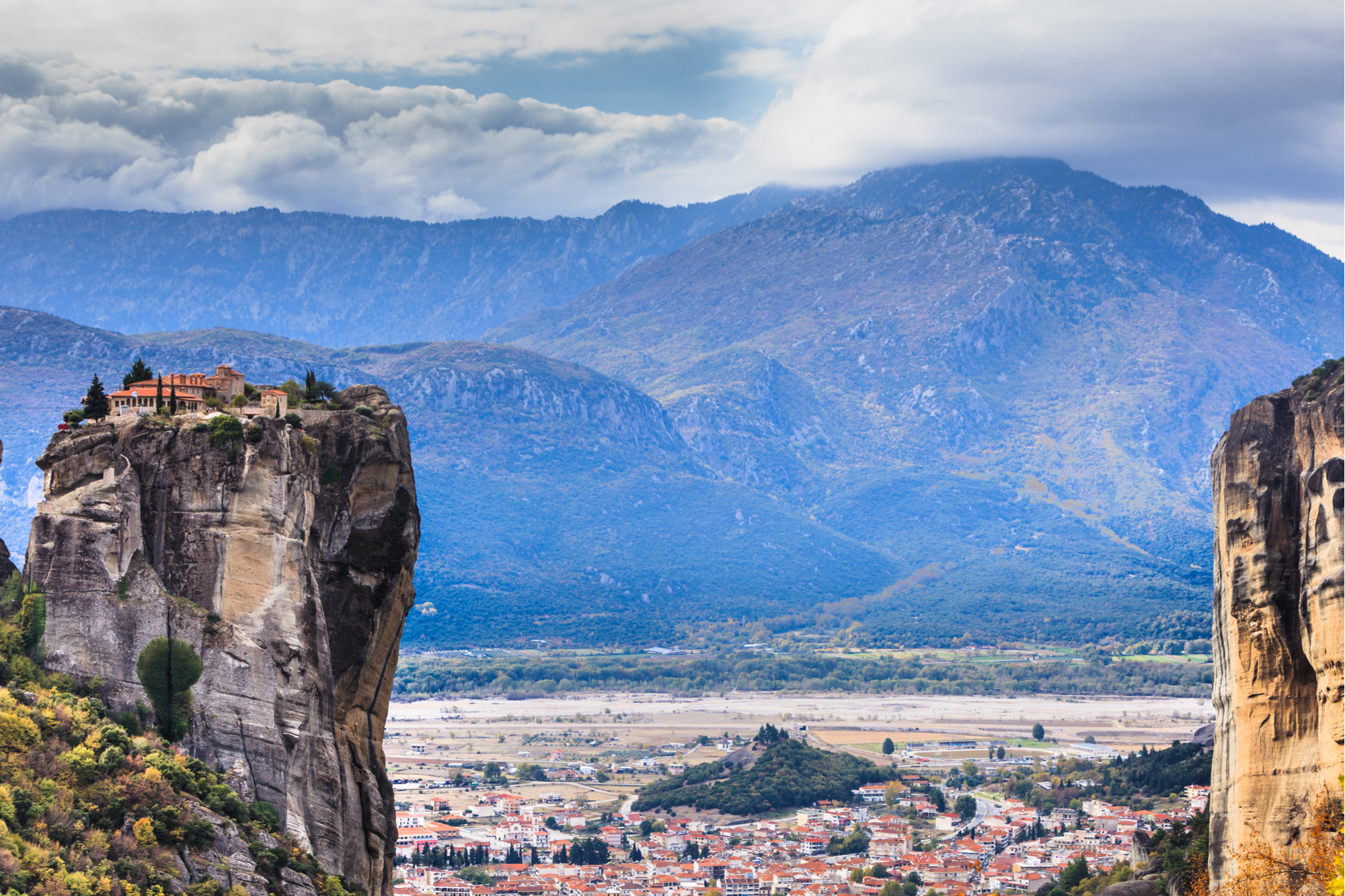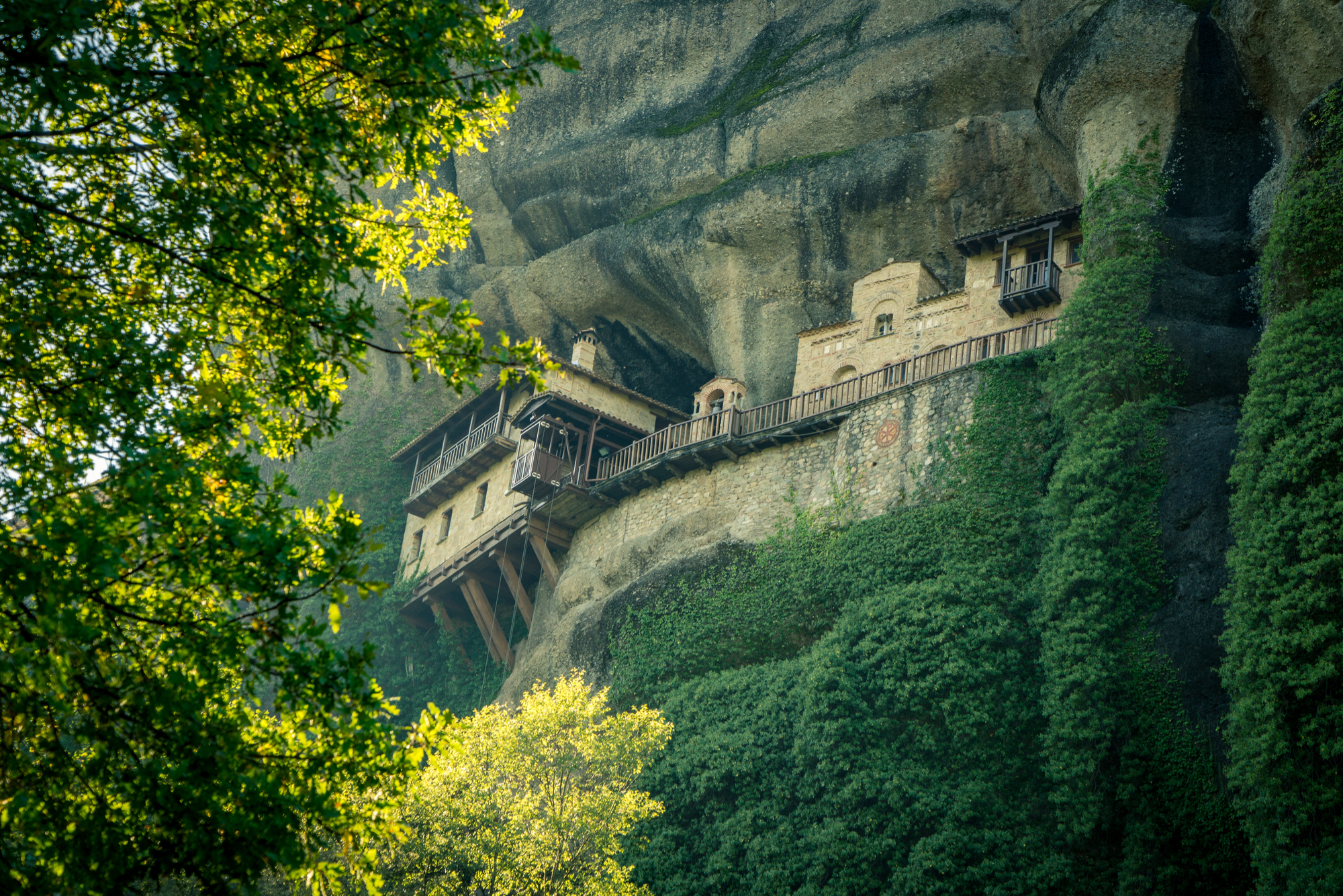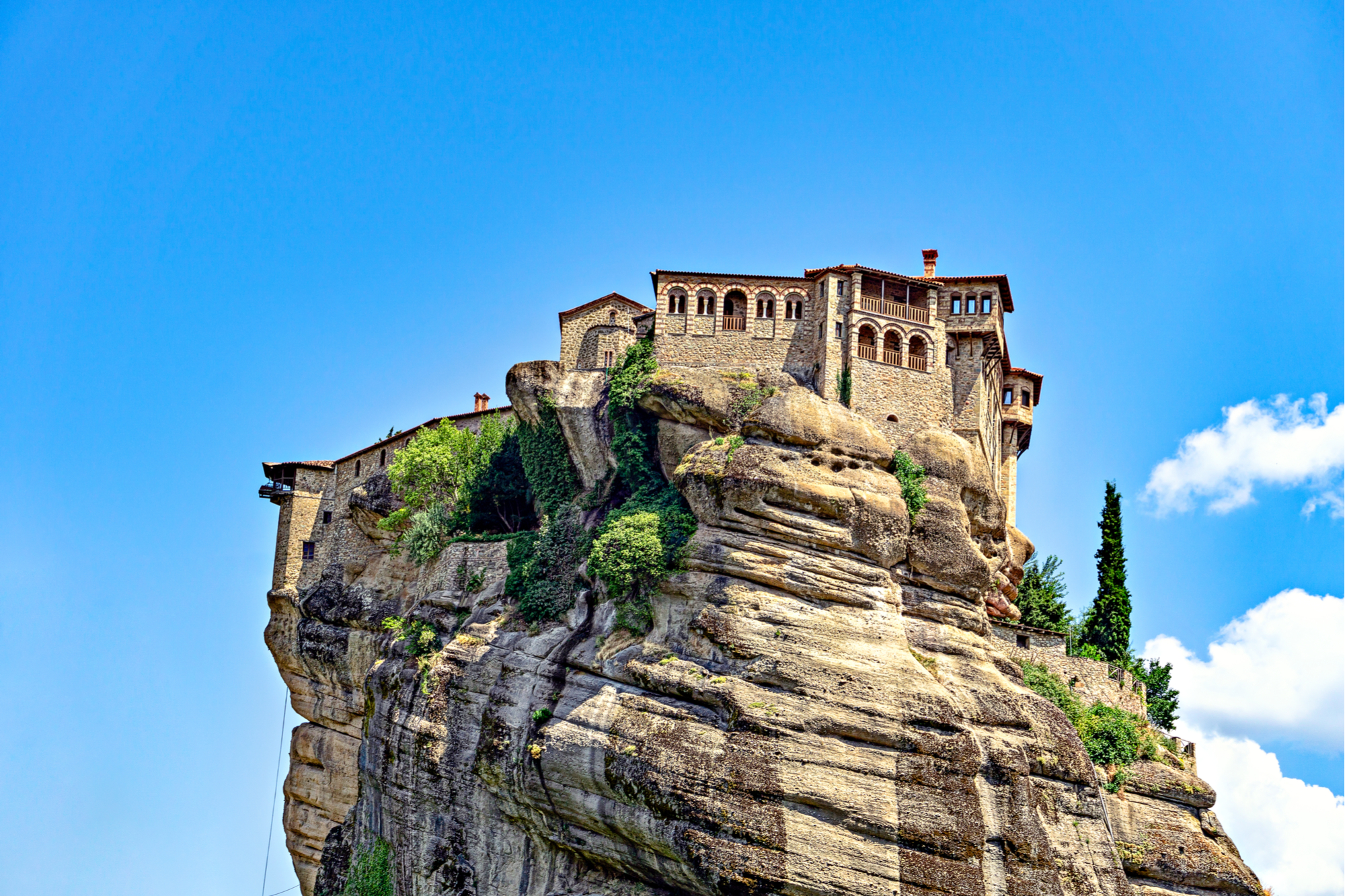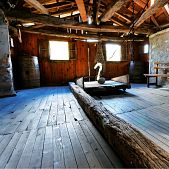
The sacred location that inspires awe
The majestic rocks of Meteora dominate Kalambaka, between the mountains of Koziakas and Antichasia. This magnificence of nature reveals all its grandeur for centuries now, as it is a unique geological phenomenon and an important monument to Orthodoxy. Meteora has been characterized as the second Mount Athos -commonly referred to in Greek as the “Holy Mountain” (Agion Oros) and continues the monastic tradition for about six centuries.
In central Greece, specifically in the Northwestern part of Thessaly between Chasia, Northeast, and Pindos to the West, where the Thessaly Valley ends, giant rocks rise, creating a possibly unique sight in the whole world.
At the view of these sacred rocks, the visitor is stunned by the impressive grandeur of this gigantic stone complex. The ascetic structures in the rocks testify to the irrepressible presence of the first monks who devoted their soul and body to God. Servants of Jesus Christ recorded their ascetic course in monastic life, marching on the paths that lead from Earth to the sky.
It is remarkable that the phenomenon of these rocks is not mentioned in mythology either by a Greek or foreign historian. For about a thousand years, historians and geologists have begun to study the creation of these rocks, by formulating various theories.
The most prevalent one is by the German geologist Philipsson who came to Greece in the late 19th century. According to his theory, a large river had its estuary in this area, which for millions of years was covered by a narrow and deep sea section. The river waters deposited on the estuary sedimentary materials and stones and, in general, various materials that were transported with its waters from northern parts of the central Central Europe. Since the accumulation of these materials, deltogeneous cones have been formed.
25-30 million years ago, after geological changes that took place over the centuries, the central part of today’s Greece was raised and the area of Thessaly, which was a lake, sunk. Later, the opening of Tempi was created, causing the waters to pour into the present Aegean and to reveal the Thessalian plain.
During the tertiary period during the alpine ridges, the compact volumes of the “rocks” were cut off from the Pindus mountain range that was created and over the centuries the valley of the Pinios River was formed between them. With constant erosion from the winds and rains, as well as from other geological changes, these rocks have gone through their millions of years in their present form.
In the cavities of the rocks, their slits and their tops, the people of the area found protection from the raids of various conquerors and those who passed through the area. In these rocks they found shelter and several daring hermits and deserters who sought peace, tranquility and prayer pursued Christian perfection. In the beginning, the ascetics were isolated and prayed in small chapels, the so-called “prayers”, not only for their own salvation but also for the salvation of all people. Their life was simple and labor painful.
Exactly when the rocks were initialy inhabited, it is not known, but according to the scriptures that exist, monasticism is presented when it was organized. According to Byzantinologists, the first ascetics must have roamed to the rocks towards the end of the first millennium. As the first ascetic, Barnabas refers to about 950-970 AD, who founded the Cloister of the Holy Spirit, followed by the foundation of the Cloister of the Transfiguration by the Cretan monk Andronikos at the beginning of 1000 AD. Then the cave of Dionysia or Dapiani was founded around 1150-1160 AD.
The first monasteries were built with great attention and remarkable craftsmanship in the 14th century. Over the years, some of them have been reconstructed, while others have had to be repaired in order to complete them, thus giving their final architectural form. Since then they have been standing on top of the rocks, giving the impression that they are their natural finish. The climb was previously done with scaffolding supported by beams embedded in the rocks, with a net, and a little later with ladders. Today the pilgrims use the stairs that were carved on the rocks, thus ensuring a comfortable and safe climb to the monasteries.
Of the 24 monasteries today are six, while the remaining 15 are uninhabited and dilapidated. The Holy Monasteries of the Transfiguration of the Savior, the Holy Trinity, St. Nicholas of Anapache and Varlaam are male, while the Holy Monastery of Rousanou and Saint Stephen are women. Today, the six monasteries that can be visited are: The monastery of Agios Nikolaos of Asmenos or Agios Nikolaos Anapafsas, built in the 16th century, has a small chapel, decorated by the famous Cretan painter Theophanis Stratlis in 1527. A monk dwells there from 2015. The Rousanus Monastery or Arsani was founded in the middle of the 16th century and was decorated in 1560. Today it is a flourishing monastery with over 10 nuns (2015). The male monastery of Metamorphosis of the Savior, on the highest rock. The Monastery of Agii Pantes or Varlaam Monastery, the Holy Trinity Monastery (Meteora) and the female monastery of Saint Stephen (Meteora).
Monks, priests and great hagiographers of the time, such as Theophanis and Fragos Kateranos, painted the temples of Meteora with frescoes. The Virgin Mary, Thornodousa, the Crucified, the Birth of Christ, the Martyrdom of the Saints, is from the wonderful iconographic program of the wall paintings that adorn the interior of the temples. They have rich coloration, sometimes vivid and sometimes soft, attributed life and naturalness to expressive faces and their movements, and the themes are inspired mainly by christian and hagiological life. Some frescoes, however, suffered severe damage from vandal raids that did not respect the sanctity of the ecclesiastical space, and others bear on them the indelible signs of wear and tear of time. Still-life paintings are part of the last Paleologian Byzantine period.
Meteora is home to treasures, heirlooms and many miniature crafts. A representative miniature piece is the masterful wood-carved iconostasis located in the catholic of the Holy Monastery of St. Stephen. Portable icons, the oldest of which are now kept in the temples of the temples, Crosses with Timber Wood, archaic rods, golden vestments, manuscripts, gospels, vessels for operational purposes, leaded, silver relics are some of the museum exhibits that the visitor can to admire. From the historical point of view, the more than one thousand manuscript codes, as well as the valuable in value series of Byzantine and post-Byzantine documents, are preserved and kept in the archives of the monasteries. In the Holy Monastery of St. Stephen is also kept the Miraculous Carat of Saint Charalambos, while in the Varlaam Monastery there is the Gospel attributed to the Emperor of Byzantium Konstantinos Porphyrogennetos.
Today, Meteora has been designated by the UN and UNESCO as a Cultural Heritage Monument. Through this inheritance, the monks-ascetics have traveled for centuries by following the steps of their first settlers Fathers, sculpting their faith with obedience, unceasingness, humility, fasting, and unceasing prayer to the Creator. After about two hundred years, in the middle of the 14th century (1340-1350 AD), the Monastery of the Transfiguration of the Savior was founded by Saint Athanasios, who gave the Great Rock “Platis Lithos” the name of Meteoros and since then all the rocks bear this name.
Then we have the creation of many monasteries within two centuries (14th – 15th), a period of great prosperity in Meteora. The number of them then reaches 24. In the middle of the 14th century, the reverend of the Cloister of the Doupiani, monk Nilos, who is the founder and Ippapanti, was very active and the founder of the Monastery of Ascension in which very important wall paintings were created. The first ascetics climbed to the rocks using scaffolds that supported them in beams wedged into holes in the rock. Later, they used the ladders and the net until the first stairs were carved in the early 20th century.
Over the centuries and under various difficulties of the times, such as the various conquerors of the region, the raids of robbers and other factors, many of the thriving Holy Monasteries led to abandonment and destruction (a period of decline after the 17th century). Today the tradition of Orthodoxy continues for more than 600 years, in the Holy Monastery of Meteoros (or Metamorphosis of the Savior), in Varlaam Monastery, in Holy Monastery of Saint Stephen, in Holy Trinity Monastery, in Holy Monastery of Agios Nikolaos Anapafsas and in the Monastery of Rousanou.
Also, with the sincere efforts of the monks, the metropolitan of Stagon and Meteora, Mr. Seraphim and the assistance of the State, the European Union and various citizens, the sacred monasteries of Saint Nicholas Bantova (Metohi of the Holy Trinity Monastery) and Ypapanti (Metohi of the Monastery of Metamorphosis or Grand Meteora) were preserved and restored.
UNESCO has designated Meteora as a Monument of Humanity. Therefore, they belong not only to Greece but also to the whole world. The same applies to Mount Athos, Mystras, the Monastery of Osios Loukas etc. The Meteora Monasteries are among the World Cultural Heritage Monuments because they are a unique harmonious match of Byzantine architecture and natural beauty. The buildings of the monasteries look like a continuation of the rocks, like a natural ending. And why is it an invaluable artistic and heirloom treasure. Furthermore, the presence of many monasteries in such a small space, as well as the orthodox spiritual life and exercise, caused the admiration of people all over the world. Finally, because the monasteries are bodies of culture, which -as we know- cannot be limited to any homeland.
Moreover, the Holy Meteora is a monastic state of the Orthodox Church in a single region, preserved by the creation of the unchanging. The Meteora monasteries function as communes, everything is common. There is a common bank (food) for all the monks. No one has any money. The fund is common, but responsible for this is the abbot who takes care of all the brotherhood of the monastery. Everything the monk does, he asks for the permission and the blessing of the abbot, to whom he speaks all his thoughts and accepts spiritual guidance from him, so that at the end of his life he may be sanctified.
The monks try to adhere to exactly three basic rules of monasticism: purity, abstention and obedience. They wake up at 3.30am and they each pray individually in his cell until 5:00 am From 5.00am until 7.30 am in the temple, the sequences of the Monthly, the Orthodox and the Hours. They pray and fast according to the rules of the Orthodox Church. They care for the salvation of their souls, but at the same time they care about their neighbor and try to help him in many ways. When a young person or a new one comes to the monasteries to become a monk or nun, respectively, he is first tested for three years and after the permit the metropolitan becomes a monk, since, of course, the abbot considers that he is fit for lonely life.
Monks and nuns practically abandon the world and come to the monasteries to be sanctified. So their first concern is prayer. Prayer combines it with work to live spiritually and physically. The work that the monks undertake is to be said, because they are done in a spirit of love and sacrifice, but also with a lot of reverence and prayer. There are intercessions that alternate every week (church, guest house, kitchen, etc.) and those that stay constant (hagiographies, handcrafted, golden jewelry, sewing, incense and candle making). Because of the tourism, the monks are obliged to deal with the reception of the world, the pilgrimage, etc. so that those who come to Meteora will enjoy much of the Orthodox Tradition and the lively faith of the monks.
The contribution of the Meteora monasteries to the cultural heritage is very important at all levels (local, national, global). The Meteorite Fathers did not start to create culture on these inhospitable rocks. Culture was a natural consequence of their love for God. Thus the industriousness, self-sacrifice, spirituality and retreat have attributed to the monasteries of Meteora excellent architectural beauty, masterpieces, magnificent golden jewels and other works of art. The greatest treasure they preserve is the holy relics of our saints and the life of Christ.
Also, the contribution of the meteoric monasteries on education is very great. The Meteorite Fathers with their own money founded in the years of the Ottoman domination and after sacred schools. Thus, in the monasteries of worship, the Greek language, which was preserved along with the Orthodox Faith allowed the enslaved to maintain their national consciousness and the craving for freedom,. Also, manuscripts, prints and documents saved in the monasteries are an inexhaustible source of information, both for our ecclesiastical and for our national history. So in the difficult times that we are going through, they save our history, our national continuity, our tradition, and the original authentic form of the evangelical life that Europe seeks and which remained unchanged in the course of the 2000 years of our Orthodox Church, since the Holy Meteora are the true followers of Byzantine culture.
Guests are really excited. They feel like something is taking over. They spend a lot of time at the temple, watching everything, and many -perhaps for the first time in their lives- kneel and pray. They have many questions and ask the monks to point out a new, stress-free way of life close to God. They are not always able to understand our own values, but they want it a great deal and try to achieve it.
In Meteora, since 1920 there was again a flourishing, because stairs and bridges were built on the rocks. So there were more visitors and pilgrims, since the old way of climbing with the net, a daily confrontation with death, was a thing of the past. In 1948 the asphalt road was built and the abbey for women was abolished. Today, although Meteora is a tourist region, there is a boom of monasticism, and many young, pious and educated come to stand in the 6 monasteries that are saved and operated.
Many damages occurred during the Italian-German occupation of Greece (1941-1944) and the Civil War (1946-1949), not only by the conquerors, but also by Greeks who used the Meteora Monasteries as war shelters or basements. For example, the German mounds destroyed the icon painted with the “Pantocrator” and the four evangelical dome of the new katholikon of the church of Saint Charalambos of the Holy Monastery of St. Stephen. Also in the same monastery but in the old Catholic church (St. Stephen’s temple), the faces, especially the eyes of all saints, were destroyed.
Since the 1960s, serious restoration and construction work has begun in the Monasteries of Meteora. The restoration and preservation of the meteoric monuments continues to this day with the support of the Metropolitan of Stagion and Meteora, Mr. Serafim, the labors of the abbots and monks, the studies and constructions of the architect Sotiriou Tzimas and the supervision and assistance of the Head of the 7th Ephorate Byzantine Antiquities (Area Archaeological Service of the Region) Mr. Lazaros Deriziotis. The masonry has been assembled, they did cement injections, restorations of buildings, maintenance and cleaning of frescoes and screens. Also, two monasteries were restored, the Monastery of Agios Nikolaos Bountova, founded around 1400 and is a monument of the Holy Monastery of Holy Trinity and the Ypapanti Monastery, founded around 1366, has frescoes in excellent condition and is the “metochi” of the Monastery of Metamorphosis.
The city-gateway to Meteora is Kalambaka, which is the commercial and tourist center of the region. Here, the visitor will find many hotels, rooms to let and taverns that will make his holidays a dream. It is worth to take a walk in the old town (Spotos), which has been renovated to visit the unique School of Wood Sculpture in Greece, as well as traditional bronze sculptures, where it will rarely find handmade bronze articles. Kastraki is the most beautiful village in the area, it nests among the rocks and at the same time constitutes the base of climbers. It has restaurants, small hotels and rooms to let, as well as tourist shops. Palaio Kastraki is a traditional settlement.
Finally, climbing in Meteora never stopped. The monks and ascetics climbed up to their monasteries with ropes, nets, or just their bare hands. Climbing on the rocks of Meteora continues today. It’s a lifelong dream for many climbing enthusiasts coming from every corner of the earth. Athletes enjoy classical climbing routes, that is, lengthy and unnecessary fuses. All are traditionally drawn from bottom to top. In the eyes of the unconscious, they seem impossible, as many of them stand almost vertically at a height of half a kilometer.
Meteora means for most people what the terms “Holy Land” and “Mount Athos, Agion Oros” do, being simultaneously religious foundations of spiritual and moral radiation, as well as cultural monuments. It is a place that, with its beauty and grandeur, inspires awe -regardless of religious beliefs- and are a strong candidate as a destination worth visiting at least once in a lifetime.

































